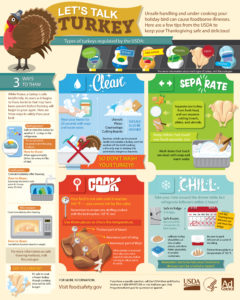Enjoy Your Turkey Safely
go.ncsu.edu/readext?495915
en Español / em Português
El inglés es el idioma de control de esta página. En la medida en que haya algún conflicto entre la traducción al inglés y la traducción, el inglés prevalece.
Al hacer clic en el enlace de traducción se activa un servicio de traducción gratuito para convertir la página al español. Al igual que con cualquier traducción por Internet, la conversión no es sensible al contexto y puede que no traduzca el texto en su significado original. NC State Extension no garantiza la exactitud del texto traducido. Por favor, tenga en cuenta que algunas aplicaciones y/o servicios pueden no funcionar como se espera cuando se traducen.
Português
Inglês é o idioma de controle desta página. Na medida que haja algum conflito entre o texto original em Inglês e a tradução, o Inglês prevalece.
Ao clicar no link de tradução, um serviço gratuito de tradução será ativado para converter a página para o Português. Como em qualquer tradução pela internet, a conversão não é sensivel ao contexto e pode não ocorrer a tradução para o significado orginal. O serviço de Extensão da Carolina do Norte (NC State Extension) não garante a exatidão do texto traduzido. Por favor, observe que algumas funções ou serviços podem não funcionar como esperado após a tradução.
English
English is the controlling language of this page. To the extent there is any conflict between the English text and the translation, English controls.
Clicking on the translation link activates a free translation service to convert the page to Spanish. As with any Internet translation, the conversion is not context-sensitive and may not translate the text to its original meaning. NC State Extension does not guarantee the accuracy of the translated text. Please note that some applications and/or services may not function as expected when translated.
Collapse ▲Having turkey for the holidays is a tradition for many, so here are some tips on how to handle the big ole bird in a safely to prevent any foodborne illnesses.
 Wash your hands before and after handling, preparing or cooking any food. This way you can prevent the spread of microbes that could make your family sick.
Wash your hands before and after handling, preparing or cooking any food. This way you can prevent the spread of microbes that could make your family sick.- Defrost the bird properly. The easiest way to defrost the turkey is in the refrigerator so you have to do some planning for that. The general rule for refrigerator-thawing time 24 hours per 4 to 5 pounds. For example: A 15-pound frozen bird will take 3 to 4 full days to thaw in the refrigerator. If you defrost it in water, use a thermometer to make sure the turkey’s temperature stays below 41º Fahrenheit.
- Separate your raw turkey from any other raw foods by using a separate cutting board for the meat or washing thoroughly the cutting boards after every use. This will prevent cross-contamination of other food items.
- Don’t wash the bird! This will not clean it, eliminate bacteria, or do anything but contaminate your kitchen counter and your turkey. This practice comes from the times when people kill their birds and needed to pluck the feathers, so it is not needed now. The only way you can kill any germs is cooking your turkey at the correct temperature, not less than 165º Fahrenheit. To measure the temperature, insert a food thermometer into the thickest part of the thigh, wing and breast, not touching the bone. try not to exceed 180º since the breast could get very dry. For more information go to Why NOT to Wash Your Thanksgiving Turkey
- Stuff safely! The US Department of Agriculture (USDA) recommends not stuffing the turkey, but cooking it separately, since the raw juices from the meat will soak the stuffing in the bird. If you would like to have a stuffed turkey, cook your stuffing and when the turkey is done, stuff the turkey with it. Check this article about stuffing Should I Precook My Turkey Stuffing?
- Refrigerate promptly! Refrigerate any leftovers within 2 hours of being cooked to prevent the rapid growth of bacteria. Divide leftovers into smaller portions and shallow containers so they cool quicker. You can eat turkey leftovers up to 4-7 days after cooked. Remember to keep your fridge between 40º-38º Fahrenheit to keep your food at a safe temperature.
For more information about enjoying your turkey and Thanksgiving Day safely check these resources:




